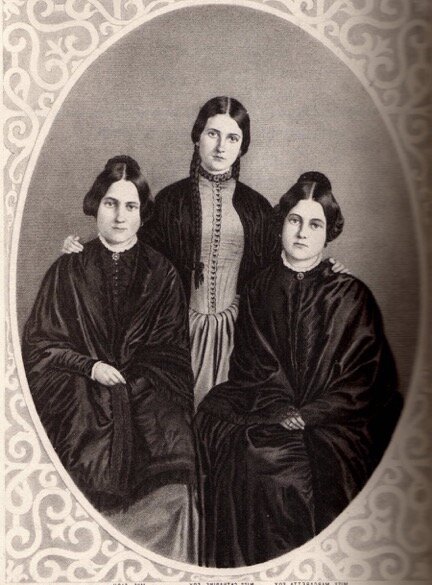The Fox Sisters
Spiritualism, a religion that at it’s peak claimed over eight million followers in the United States and Europe, has very humble beginnings indeed. In late March of 1848, in a small cottage, on a small piece of land in Hydesville, New York, the two youngest daughters of John and Margaret Fox changed the Western notions of the Beyond forever. During what one can only imagine was a combination of boredom and imaginative play Margaretta (Maggie) Fox, aged 13, and Katherine (Kate) Fox, aged 11, devised a prank to play on their parents at night.
They set about creating a series of rapping noises: made by first tying string around apples and lowering them down to thump against the floor, and then by cracking their toe joints to produce the rapping sounds. At first, their goal was merely to frighten their parents, but the game quickly evolved into a “communication with spirits”. As their parents entered the room where the girls were practicing the rapping sounds, Katie suddenly took the game one step farther by commanding the spirit to reply to her as she snapped her fingers. Needless to say, the spirit complied.
Mrs. Fox reached out to the neighbors to witness the phenomenon of the communicative spirit. Neighbor William Duesler arrived and, through a series of yes and no, and numerical questions spoken to the air, and the “rapped” replies, a story was devised about a peddler who had been murdered by the previous tenant of the cottage for five hundred dollars and buried beneath in the cellar. Oddly enough, human remains would be discovered in the cellar of the old Fox home, but, in the meantime, Mrs. Fox was convinced, Mr. Duesler was convinced, and word quickly spread. Soon the Fox home was besieged on a daily basis by people demanding to experience the haunting for themselves.
News of the marvels at the home spread quickly across New York. Leah Fox Fish, the elder sister living as a single working mother in Rochester, returned home to find the house in disarray. Her little sisters, along with their mother and father, had moved out of the house and in with eldest son David and his family. Kate and Maggie revealed to Leah how the rapping was accomplished by the cracking of their toe joints, and it was decided that Leah manage her sisters new vocation.
Leah brought Kate back to Rochester (Maggie would follow not long after with their mother), where she lived with her daughter and taught music. Rochester, in upper New York State, turned out to be a hotbed of Christian fervor and religious reform, providing fertile ground for growing belief in channeling and communicating with the dead. As can be expected, once Kate and Maggie were situated in their older sister’s home, the spirits reached out to communicate with the girls, and the house was crowded from morning to night. Visitors to Leah’s home were eager to participate in these séances with the girls, and paid one dollar each for the privilege, though many others treated the girls with contempt.
As the fervor grew, so did the peril. The Fox sisters began performing the phenomena in halls and theaters, and they were often tested for the authenticity of their séances. Usually no practical explanation could be found, although some were able to discover the trick of it, and the girls were often met with outrage for what some considered witchcraft and heresy. At the urging of friends, the Fox Sisters took their act on the road, performing in packed venue halls and theaters across New England, as well as in the homes of many of New York City’s wealthy and cultural elite.
The Fox’s spiritualist act had become a sensation. It also inspired many other mediums to demonstrate their ability to channel the dead, and hold séances of their own. The “rapping” of spirits had become a nationwide craze, and developed respectability through followers with reputable backgrounds, such as scientists and physicians, and prominent women’s rights advocates. It was a movement guided by the principle of equality to all, regardless of race, gender, ethnicity or religious affiliation. Spiritualism became a means for not only “spirits” to break through to the world of the living, but for women to break through the social restrictions of the time and use their voices to speak out. Women in this profession could acquire wealth, and social elevation on their own.
Leah Fox herself reaped all the benefits such a position now afforded her, married a Wall Street banker, and moved up in the world. But the same can not be said for younger sisters Maggie and Kate. Maggie fell into a romantic relationship with Elisha Kane, a famous Arctic explorer for whom her career in spiritual rapping was an embarrassment, both to him and his high society Philadelphia family. He would propose and marry her, he promised, only if she gave up her work, when he returned from his latest foreign expedition. However this day never came, as he grew ill and died during his travels. Kate’s husband died of a stroke. Both women developed profound drinking problems, and were eventually disavowed by Leah.
Many years later, in the fall of 1888, Maggie publicly admitted that she and her sister were frauds; unveiling their tricks and how they were achieved. Advocates of Spiritualism denounced Maggie’s confession, claiming that she and Kate had fallen into severe alcoholism and were merely trying to discredit Leah out of spite. The movement thus managed to retain it’s strength and popularity. Eventually, Maggie recanted her confession, but the careers of the Fox Sisters were by then damaged beyond repair. The alcoholism would take their lives five years later. Whether or not their spirits were ever channeled from the great beyond has not been confirmed nor denied.
Jaclyn Baer is one half of the Briar Press NY creative team.


